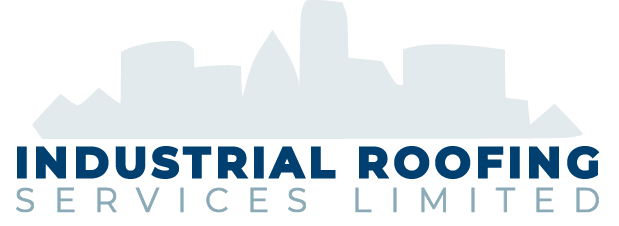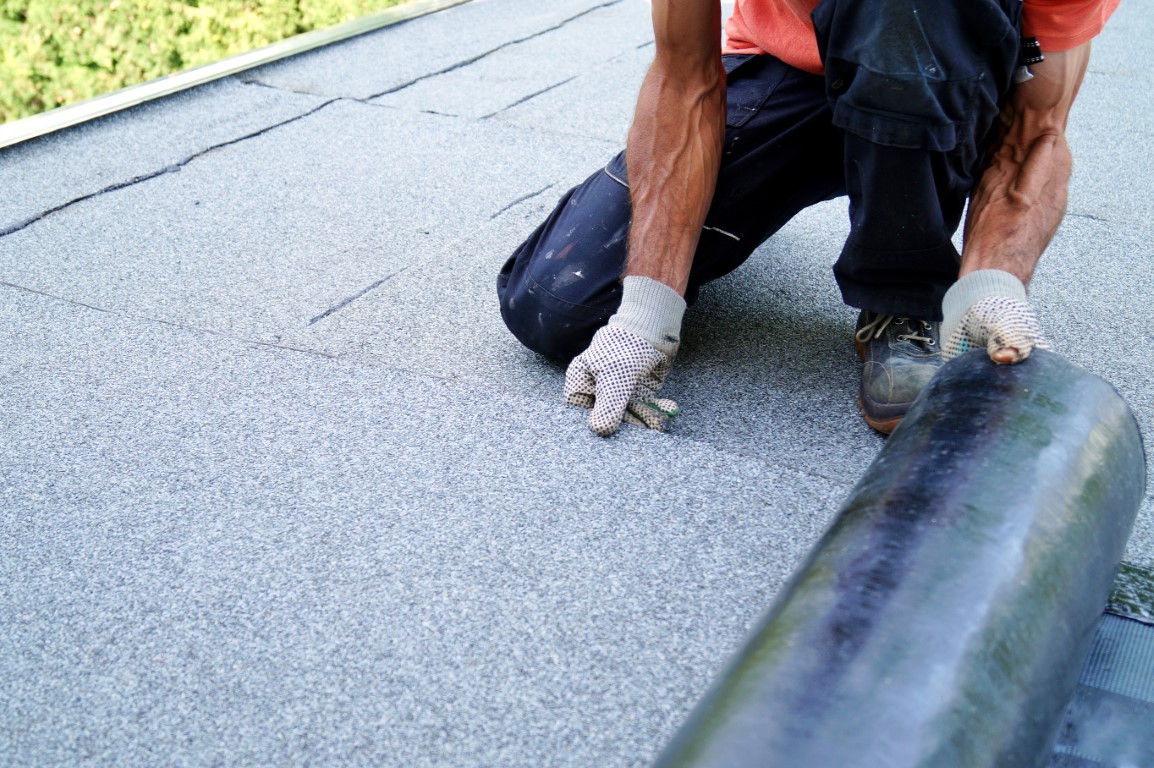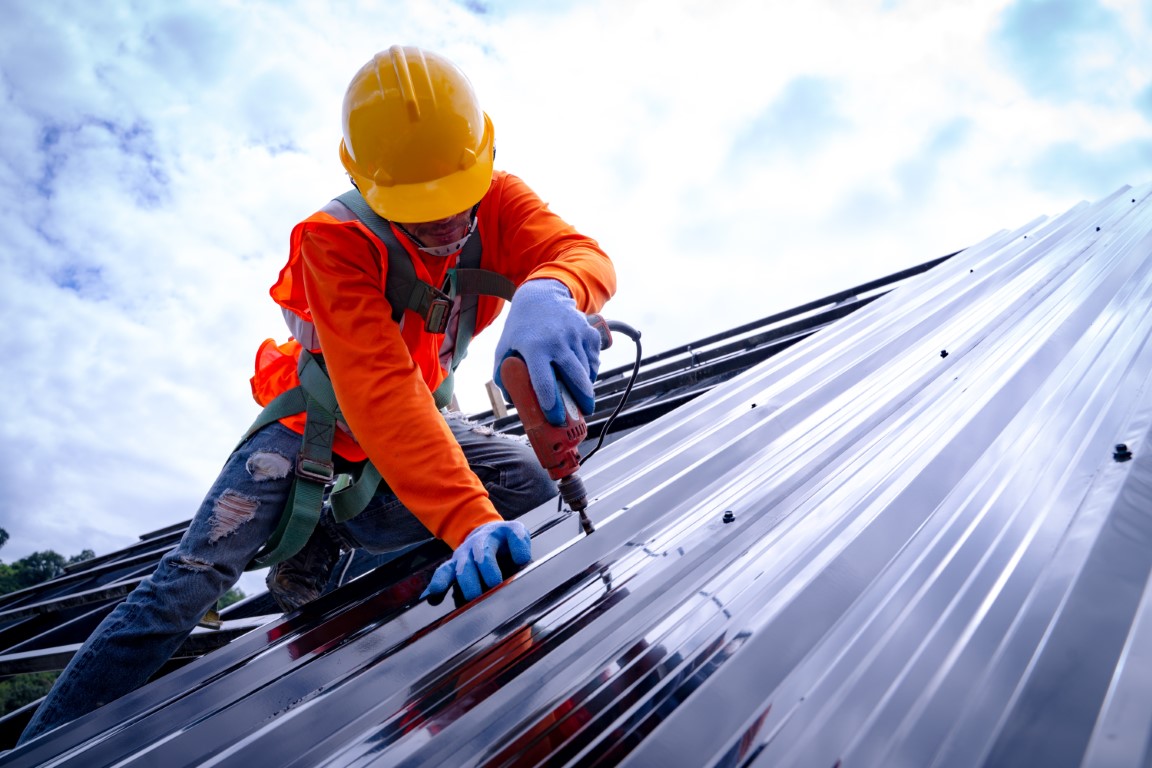Choosing the right roofing system for your commercial building is one of the most important decisions you’ll face as a property owner or maintenance manager. It goes far beyond appearances, your roof is the first line of defence against Ontario’s often unpredictable weather and plays a key role in energy efficiency, operating expenses, and the long-term health of your property.
With so many options available, it’s easy to feel overwhelmed. The reality is, there’s no one-size-fits-all solution. The best roofing system is the one that fits your property’s unique needs, your budget, environmental factors, and local regulations.
At Industrial Roofing Services Limited (IRSL), we’ve spent over 45 years helping Ontario property owners make smart, informed decisions about their roofs. This guide will walk you through the most popular commercial flat roofing systems and help you evaluate which is right for your building.
Table Of Contents:
Built-Up Roof (BUR) Systems
Modified Bitumen (Mod Bit) Systems
TPO Roofing
EPDM Roofing
PVC Roofing
Ontario Building Code Considerations
Tips To Choose The Right System For You
Built-Up Roof (BUR) Systems
What are BUR systems?
Built-Up Roofing (BUR), often known as “tar and gravel,” has been a reliable roofing solution for decades. These systems are built directly on-site by alternating layers of bitumen (asphalt or coal tar) with reinforcing fabrics like fibreglass or organic felts. The result is a tough, multi-layered membrane finished with gravel or a mineral-coated cap sheet to shield against UV rays. Today’s BUR systems sometimes use cold-applied adhesives, cutting down on fumes and simplifying installation.
Pros
- Time-Tested Strength: BUR roofs have a proven track record, often lasting 20–30 years or more with the right upkeep. The layered design offers redundancy, so if one layer fails, others provide backup protection.
- Excellent Waterproofing: Multiple layers of bitumen create a solid barrier that stands up well against water infiltration.
- Strong Fire Resistance: Especially when finished with gravel and coal tar pitch, BUR systems are a top choice where fire codes are strict.
- Good Insulation: Their dense makeup and integration with insulation help regulate indoor temperatures, potentially lowering energy costs.
- Tough Surface: BUR holds up well against foot traffic and rooftop equipment thanks to its weight and thickness.
Cons
- Heavy Load: The system is quite heavy, which might mean your building needs extra structural support.
- Complex Installation: Hot-applied BUR can be labour-intensive and produces fumes, requiring proper ventilation.
- Time-Consuming: Building up multiple layers takes longer than applying a single-ply system.
- Repair Work: Repairs can be trickier due to the layered design.
When To Choose BUR
This system is ideal for larger commercial or industrial buildings where durability and fire resistance are top priorities.
- Industrial sites that need protection from rooftop machinery or chemical exposure.
- High-traffic roofs where frequent access is necessary.
- Buildings with strict fire codes.
- Cold climate properties, where its thermal properties shine.
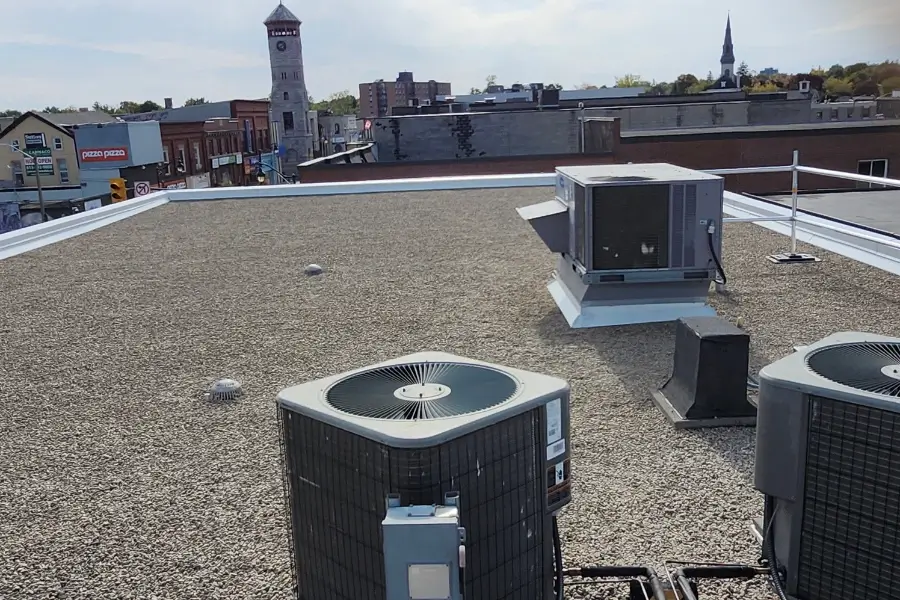
Modified Bitumen (Mod Bit) Systems
What are Mod Bit systems?
Modified Bitumen is an evolution of BUR, combining asphalt with polymers for enhanced performance. These pre-manufactured rolls are laid in one or two layers and can be torch-applied, cold-applied, or self-adhered. SBS (Styrene-Butadiene-Styrene) adds rubber-like flexibility, while APP (Atactic Polypropylene) adds plastic-like rigidity and UV resistance. Hybrid products combining both polymers offer broad performance benefits.
Pros
- Flexible & Durable: The added polymers help Mod Bit stand up to temperature swings without cracking.
- Reliable Waterproofing: Maintains excellent water resistance, even with fewer layers.
- UV Protection: Granulated surfaces help resist sun damage.
- Resists Damage: Reinforced layers handle moderate foot traffic well.
- Easy Maintenance: Patching is typically quick and effective.
- Install Options: Choose from torch, cold adhesive, or self-adhered, depending on your site’s needs.
Cons
- Installation Odour: Torch application can produce strong smells.
- Colour Limitations: Mostly offered in darker shades.
- Shorter Lifespan: Typically lasts 20–25 years – still strong, but slightly less than BUR.
When To Choose Mod Bit
A flexible option for buildings with flat or low-slope roofs, especially where installation speed and versatility matter.
- Retail or strip plazas, where appearance and performance both count.
- Smaller commercial properties, where ease of installation is key.
- Roofs with light to moderate traffic.
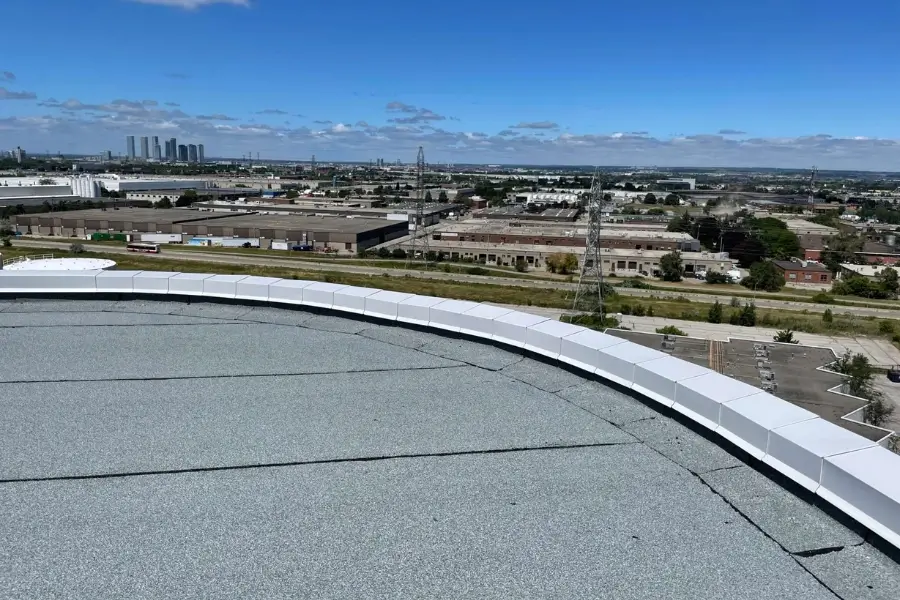
TPO Roofing
What are TPO systems?
Thermoplastic Olefin (TPO) is a single-ply roofing material known for being lightweight, cost-effective, and energy-efficient. It combines polypropylene and ethylene-propylene rubber into flexible sheets, typically white or light-colored, which are welded at the seams using hot air. This technique creates exceptionally strong and watertight seams. Modern versions incorporate nanotechnology and improved formulations for extra durability.
Pros
- Energy Efficient: Its reflective surface keeps buildings cooler in summer.
- Durable & Flexible: TPO resists punctures, UV damage, and chemicals.
- Lightweight: Great for retrofits that can’t handle extra weight.
- Quick Installation: Large rolls and clean application speed up projects.
- Cost Savings: Lower upfront and operating costs.
- Eco-Friendly: Many TPO products are recyclable.
Cons
- Seam Issues (in the past): Older formulations had seam problems, though modern TPO has addressed this.
- Puncture Risk: Being single-ply, it’s more prone to damage if unprotected.
- Installer Skill Required: Proper seam welding demands experience.
When To Choose TPO
An increasingly popular choice for buildings seeking energy efficiency and a clean, modern roof surface.
- Office buildings, where energy costs matter.
- Warehouses and logistics centers that need fast, large-scale installation.
- Green buildings seeking LEED points.
- Low-maintenance properties, where a simple solution is best.

EPDM Roofing
What are EPDM systems?
EPDM (Ethylene Propylene Diene Monomer) is a synthetic rubber membrane popular for low-slope roofs. Available in black or white, it’s flexible, durable, and cost-effective. EPDM roof installations can be done mechanically, fully adhered, or ballasted. Seams are sealed with adhesives or specialized tapes. Modern products have improved thickness and seam strength for better resilience.
Pros
- Extremely Durable: Often lasts 30+ years with proper care.
- Cost-Effective: Among the most affordable roofing options.
- Handles Ontario Winters: Stays flexible in freezing temps.
- Simple Repairs: Easy to patch with kits or adhesives.
- Lightweight: Minimizes structural impact.
- Quick Install: Large sheets reduce labour time.
Cons
- Heat Absorption: Black EPDM absorbs heat (can be a benefit in winter).
- Puncture Risk: Sharp tools or heavy foot traffic can damage it.
- Seam Dependence: Adhesive-sealed seams require experienced installers.
When To Choose EPDM Roofing
A dependable, budget-friendly option for properties that value longevity and ease of upkeep.
- Industrial sites or warehouses, focused on function over form.
- Harsh weather zones, where freeze-thaw cycles are common.
- Low-maintenance buildings, where simple repairs are a plus.
- Back-of-house properties, where appearance isn’t a top concern.
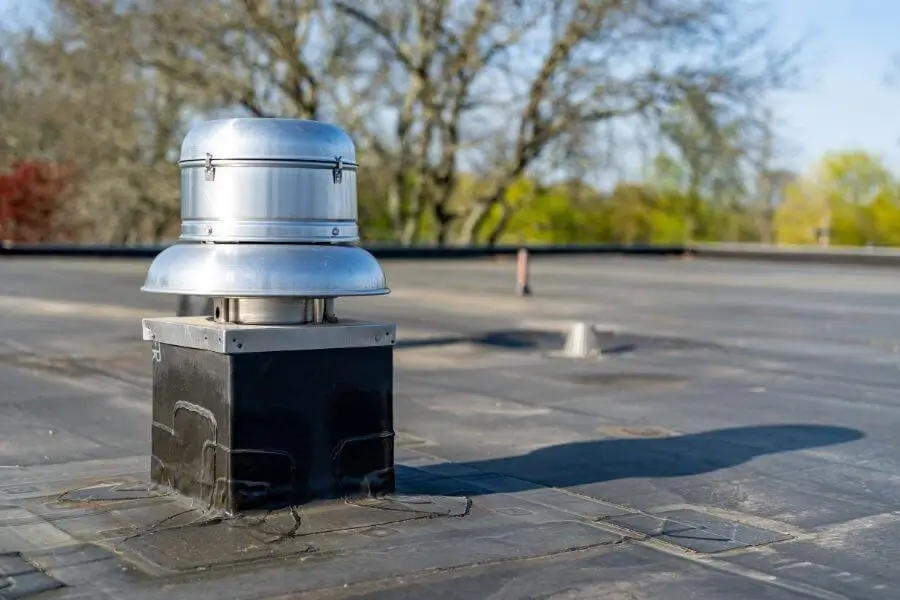
PVC Roofing
What are PVC systems?
PVC (Polyvinyl Chloride) is another single-ply membrane, known for its strength and resistance to chemicals, grease, and fire. Like TPO, it uses hot-air welded seams, but it’s often reinforced with scrims for added toughness. It’s commonly installed on buildings with chemical exposure or frequent rooftop activity.
Pros
- Chemical Resistance: Unmatched in its category, ideal for food and manufacturing environments.
- Top-Tier Fire Safety: Flame-retardant and self-extinguishing.
- Long Lifespan: Reinforced seams and durable material last 20–30 years.
- Energy Efficient: Light-colored surfaces reflect heat.
- Watertight Seams: Welded seams outperform adhesive alternatives.
- Handles Traffic: Great for busy rooftops with equipment or foot access.
Cons
- More Expensive: Higher material and labour costs.
- Can Be Heavier: Especially thicker, reinforced versions.
- Installation-Sensitive: Demands skilled installers with proper equipment.
When To Choose PVC Roofing
A premium system for demanding environments.
- Restaurants and kitchens, with grease-exposed exhausts.
- Chemical plants with exposure risks.
- Fire-sensitive buildings.
- Energy-conscious designs.
- Busy rooftops, with frequent activity or heavy equipment.
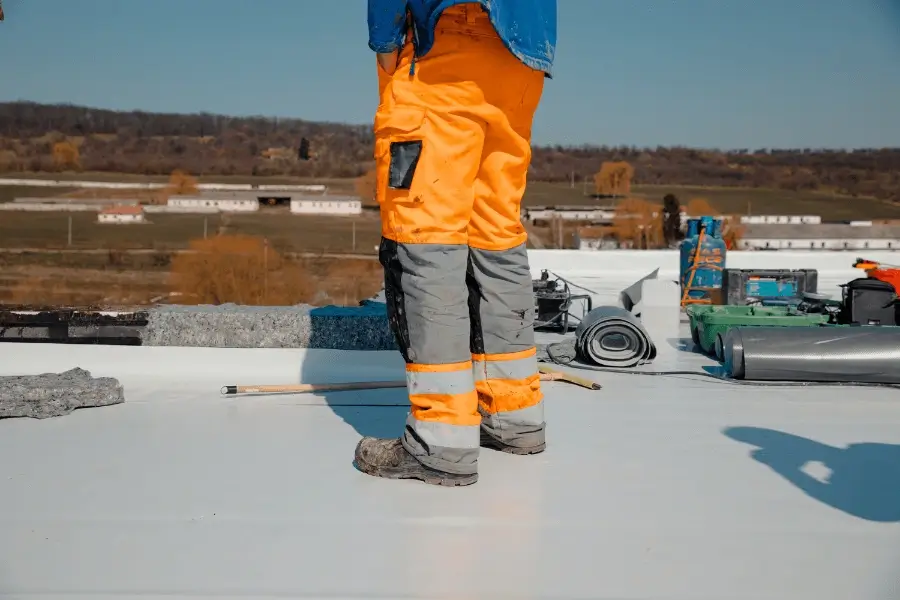
Ontario Building Code Considerations
Any roofing project in Ontario must follow the Ontario Building Code (OBC), which covers safety, energy efficiency, and more. Here’s what to watch for:
- Structural Requirements: Your roof must bear snow, wind, and seismic loads. BUR’s weight may need a structural assessment.
- Fire Ratings: Roofing materials must meet fire code based on your building’s use. PVC and some BUR systems offer top fire resistance.
- Energy Rules: The OBC mandates insulation and airtightness. Good roofing helps with compliance and lowers bills.
- Ventilation: Essential for moisture control and roof health.
- Permits & Inspections: Major projects need municipal permits and regular inspections. A contractor familiar with OBC ensures everything checks out.
Tips To Choose The Right System For You
Here’s a quick checklist to help decide which system fits your property:
- Assess Building Use: Is it industrial, retail, or office space? Consider indoor activities, rooftop needs, and exposure to chemicals.
- Evaluate Structure: Is your roof truly flat or low-slope? Can it support a heavier system like BUR?
- Foot Traffic: Will maintenance teams regularly access it? Choose more puncture-resistant materials like PVC or Mod Bit.
- Think About Climate: Ontario’s winters, summers, and storms require a flexible, weather-tough system.
- Energy Goals: Want lower cooling bills? Go for reflective TPO or PVC. Don’t forget proper insulation.
- Lifespan & Maintenance: Choose a system that matches your budget and appetite for upkeep.
- Budget Realistically: Weigh both upfront and lifetime costs, including maintenance and energy savings.
- Understand Warranties: Know what’s covered by material and labour warranties.
- Hire the Right Partner: Choose an experienced commercial roofer like IRSL – licensed, insured, and WSIB-certified.
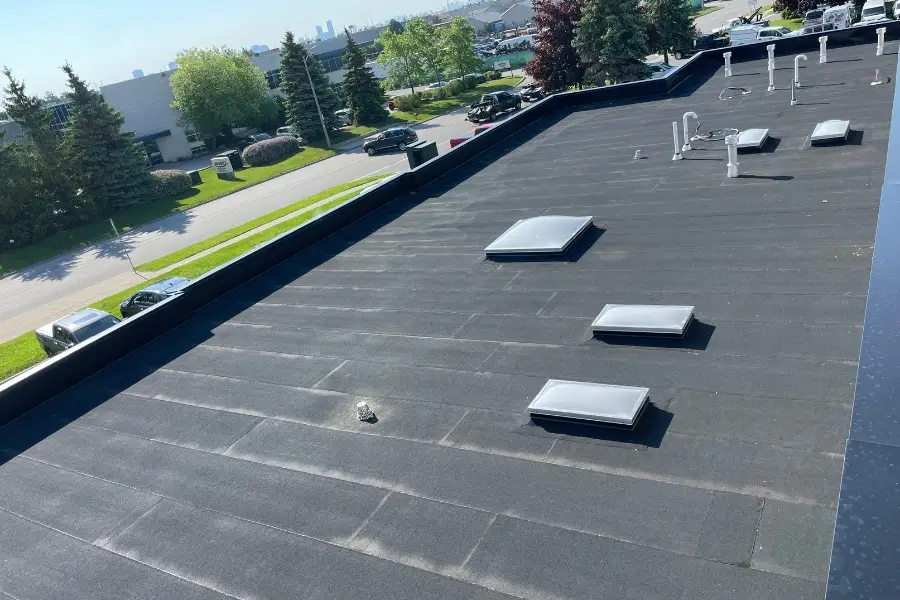
Your roof is a long-term investment, and choosing the right system means protecting your property for decades. While this guide gives you a strong foundation, working with an expert ensures you get a tailored solution that meets all regulations and performance goals.
At Industrial Roofing Services Limited, we’ve spent over four decades helping property owners across Ontario choose, install, and maintain their roofing systems. Our team is bonded, insured, safety-certified, and available 24/7. Whether you need installation, emergency repairs, or regular inspections, we’ve got you covered.
Get in touch today for a personalized consultation and detailed quote. Let’s build a better roof together.
